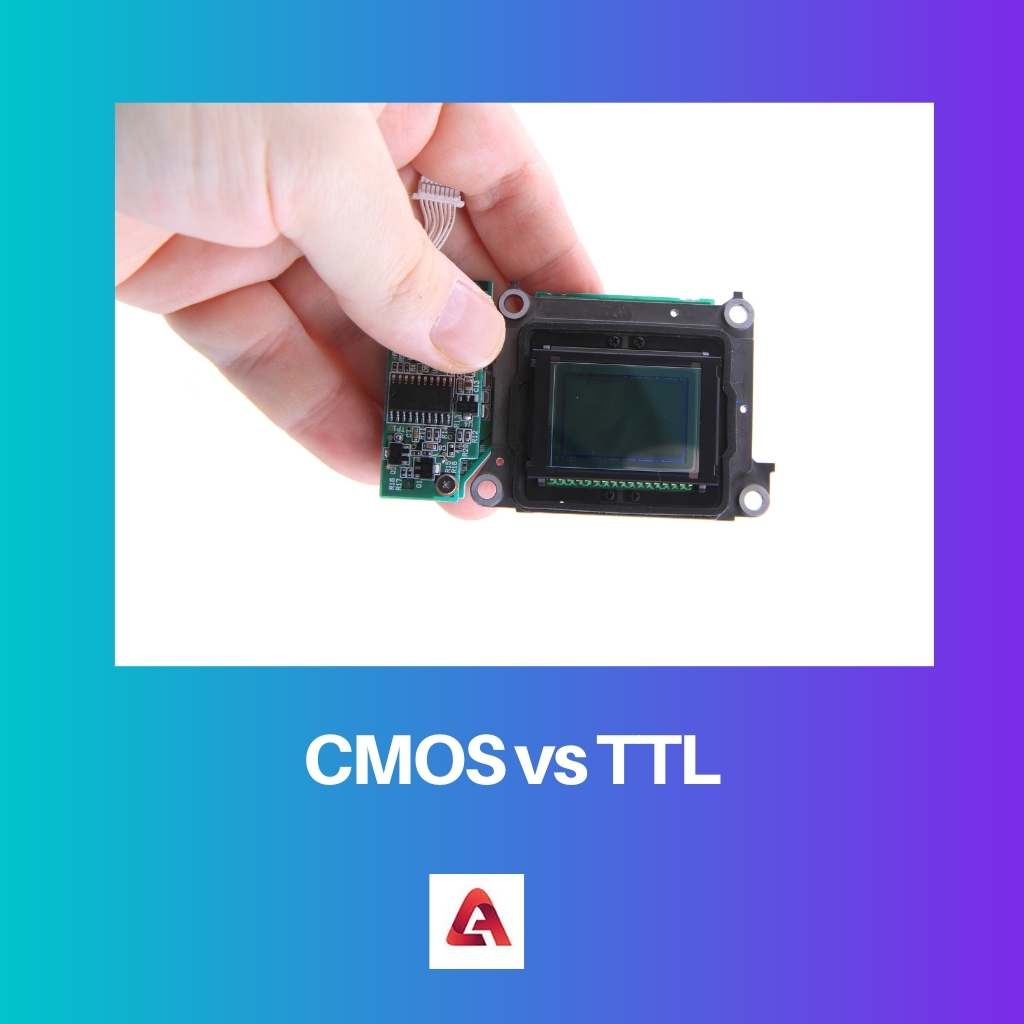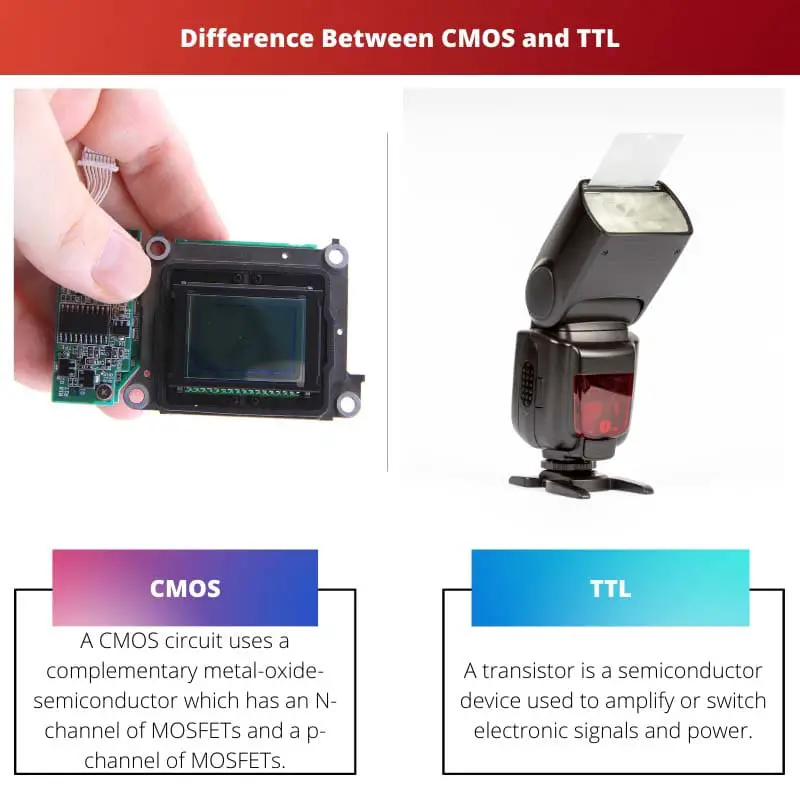There are two different types of computer chips: CMOS and TTL. CMOS stands for complementary metal-oxide-semiconductor. TTL stands for transistor-transistor logic. They’re both oftentimes used to make microchips. However, they’re both different and serve different functions. To learn more about the difference between CMOS and TTL, we must understand its functioning.
Key Takeaways
- CMOS circuits consume less power than TTL circuits, making them suitable for battery-powered devices.
- TTL circuits switch faster than CMOS circuits, providing quicker application response times.
- CMOS technology is more susceptible to static discharge damage than TTL technology.
CMOS vs TTL
The difference between CMOS and TTL is that CMOS (complementary metal-oxide-semiconductor) is an electronic component in the logic family. CMOS is used in computers and various other electronic devices. TTL (transistor-transistor logic) is a type of digital logic in the logic family. TTL is also used in computers and various other electronic devices.

CMOS, Or complementary metal oxide semiconductor, uses PMOS and NMOS types of field-effect transistors to handle input and output. They are commonly used in NAND and NOR gates and are economically efficient, and have a higher clock rate making them consume more power than TTL or transistor-transistor logic units.
TTL and Transistor-Transistor Logic Units are made up of BJTs Or bipolar junction transistors that commonly have multiple inputs and outputs. They have a slightly lower density of logic gates and are found with NANA gates. However, they consume less power and hence are used in several devices.
Comparison Table
| Parameters of Comparison | CMOS | TTL |
|---|---|---|
| Full-Form | CMOS is the abbreviation of Complementary Metal Oxide Semiconductor. | TTL is the abbreviation of Transistor-Transistor Logic. |
| Invented In | CMOS is the newer technology invented in the year 1968. | TTL was invented in the year 1963. |
| Technology Used | Technology used in CMOS units is MOSFET. | The technology used in TTL units is BJTs. |
| Efficiency | CMOS units are more efficient than TTL units. | TTL units are less efficient than CMOS units. |
| Noise | CMOS produce less noise. | TTL units produce more noise. |
| Static Damage | CMOS units are susceptible to damage by changes in static electricity. | TTL units are less susceptible to damage by changes in static electricity. |
What is CMOS?
A CMOS circuit uses a complementary metal-oxide-semiconductor which has an N-channel of MOSFETs and a p-channel of MOSFETs. CMOS circuits are very low power. CMOS circuits are resistant to noise. CMOS circuits are used in digital devices, while TTL circuits are used in digital devices that are also analogue.
CMOS stands for complementary metal-oxide-semiconductor, which is an integrated circuit technology. And this type of technology was used in all electronics until the 1980s when it was replaced by TTL technology. However, CMOS technology is still used in many devices even today.
CMOS circuits are used in laptops, cell phones, digital cameras, scanners, printers, etc. TTL circuits are used in computers, microprocessors, calculators, etc. However, one of the biggest disadvantages of CMOS is that it is very susceptible to changes in static electricity and has a high clock rate. Also, it is more expensive than TTL units.
Generally, a higher clock rate makes it consume more power, and although it is economically more efficient than TTL, it does consume more power. CMOS IC units can also be used in microprocessors, sensors, memory chips, etc. It is a fairly popular type of IC unit used today.

What is TTL?
A transistor is a semiconductor device used to amplify or switch electronic signals and power. It was invented in 1947 by John Bardeen, Walter Brattain, and William Shockley. A transistor is a switch. It is an electrical component that can be used to amplify the signals. It can also be used to switch on and off an electrical current.
In electronics, Transistor-Transistor Logic (TTL) is a family of logic families based on bipolar junction transistors (BJTs) and their low-power CMOS variants. In TTL, a high voltage of 1.4 V is represented by a binary 1 and a low voltage of 0.8 V by a binary 0. The TTL was the most commonly used logic family from the 1960s into the 1980s, when CMOS slowly took over. CMOS, which is an enhancement of bipolar technology, soon became a lower-power alternative to TTL.
However, TTL units are still found in transistors and resistors and are commonly used with NANA gates. They have their advantages, like a lower clock rate, less power consumption, and less expensive TTL units. Also, they can handle more input and output channels than CMOS IC units.
The density of logic gates, however, is lower than CMOS units, and it’s not as efficient and produces noise as well. That being said, it was a popular choice until the 70s and is still used to date, however, less frequently than CMOS units.
Main Differences Between CMOS and TTL
- Firstly, CMOS and TTL are different types of logic gates. A TTL gate uses transistors, while a CMOS gate uses MOSFETs.
- Next, CMOS gates are also more expensive than TTL units.
- CMOS gates are smaller, meaning they require less power In competition to the bulkier TTL units.
- While TTL is easier to use, CMOS is more efficient for long-term use.
- CMOS gates can also be designed inside a DIP chip, which TTL gates aren’t able to do.
- CMOS uses symmetrical and complementary p and n-type metal-oxide field-effect transistors in its fabrication, while TTL units are composed of bipolar junction transistors only. These transistors perform all the logic functions.
